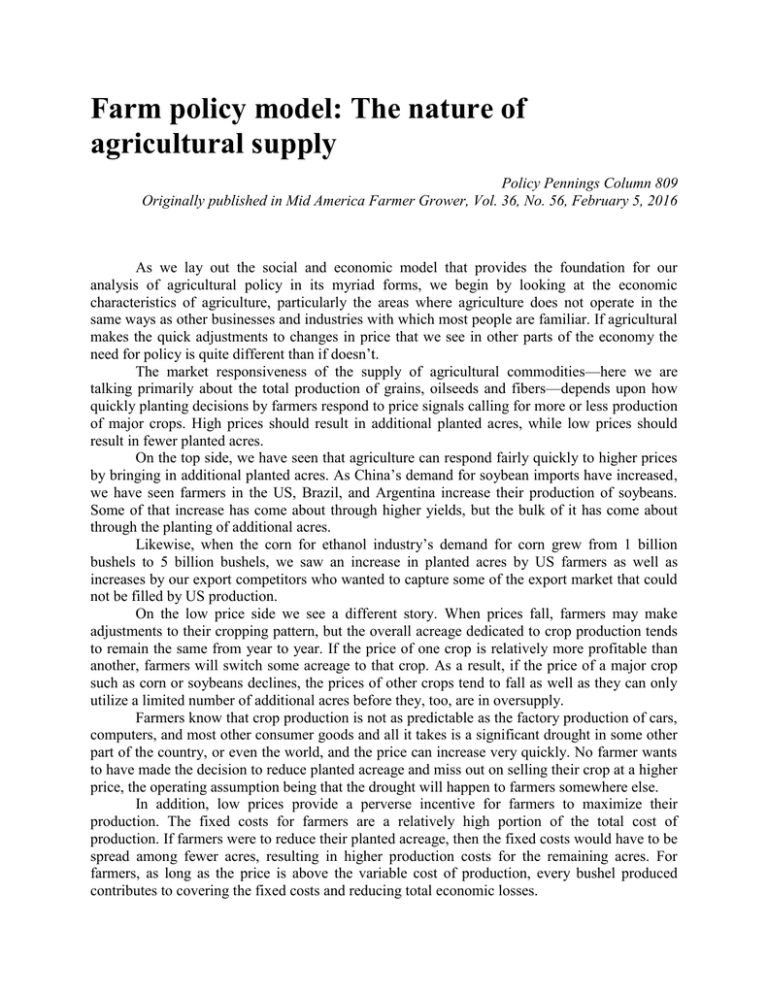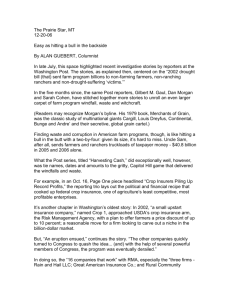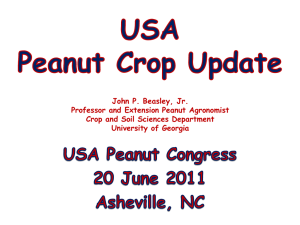Farm policy model: The nature of agricultural supply
advertisement

Farm policy model: The nature of agricultural supply Policy Pennings Column 809 Originally published in Mid America Farmer Grower, Vol. 36, No. 56, February 5, 2016 As we lay out the social and economic model that provides the foundation for our analysis of agricultural policy in its myriad forms, we begin by looking at the economic characteristics of agriculture, particularly the areas where agriculture does not operate in the same ways as other businesses and industries with which most people are familiar. If agricultural makes the quick adjustments to changes in price that we see in other parts of the economy the need for policy is quite different than if doesn’t. The market responsiveness of the supply of agricultural commodities—here we are talking primarily about the total production of grains, oilseeds and fibers—depends upon how quickly planting decisions by farmers respond to price signals calling for more or less production of major crops. High prices should result in additional planted acres, while low prices should result in fewer planted acres. On the top side, we have seen that agriculture can respond fairly quickly to higher prices by bringing in additional planted acres. As China’s demand for soybean imports have increased, we have seen farmers in the US, Brazil, and Argentina increase their production of soybeans. Some of that increase has come about through higher yields, but the bulk of it has come about through the planting of additional acres. Likewise, when the corn for ethanol industry’s demand for corn grew from 1 billion bushels to 5 billion bushels, we saw an increase in planted acres by US farmers as well as increases by our export competitors who wanted to capture some of the export market that could not be filled by US production. On the low price side we see a different story. When prices fall, farmers may make adjustments to their cropping pattern, but the overall acreage dedicated to crop production tends to remain the same from year to year. If the price of one crop is relatively more profitable than another, farmers will switch some acreage to that crop. As a result, if the price of a major crop such as corn or soybeans declines, the prices of other crops tend to fall as well as they can only utilize a limited number of additional acres before they, too, are in oversupply. Farmers know that crop production is not as predictable as the factory production of cars, computers, and most other consumer goods and all it takes is a significant drought in some other part of the country, or even the world, and the price can increase very quickly. No farmer wants to have made the decision to reduce planted acreage and miss out on selling their crop at a higher price, the operating assumption being that the drought will happen to farmers somewhere else. In addition, low prices provide a perverse incentive for farmers to maximize their production. The fixed costs for farmers are a relatively high portion of the total cost of production. If farmers were to reduce their planted acreage, then the fixed costs would have to be spread among fewer acres, resulting in higher production costs for the remaining acres. For farmers, as long as the price is above the variable cost of production, every bushel produced contributes to covering the fixed costs and reducing total economic losses. A significant portion of agricultural land is rented. It makes little economic sense for farmers to pay the rent on that ground and not produce a crop or deliberately produce a smaller crop. And even if they did that, the landlord might begin asking questions about why they left some of the land idle. With farmers scrambling to farm as many acres as possible, they are not likely to tell the landlord to rent it out to someone else this year because if they did they would never get to farm that ground again. Farmers who own a significant portion of their land outright can ignore the land costs and thus retain a positive cash flow at lower prices than those who are purchasing or renting the ground they farm. As a result they will continue to plant all of their land when prices are low No one farmer has the ability to affect a crop’s price by reducing her planted acreage. Each farmer makes his decision based not on the macroeconomics of aggregate crop production but on the microeconomics of his or her own farm. That means if they can sell the crop for more than the variable cost of production, their intent is to plant all of their acres. In the next column we will look at additional reasons why farmers do not quickly reduce their planted acres in response to low prices. To the extent that farmers do not reduce their production in the short- to medium-run, they face long periods of low prices punctuated by short periods of higher prices. Harwood D. Schaffer is a Research Assistant Professor in the Agricultural Policy Analysis Center, Institute of Agriculture, University of Tennessee. Daryll E. Ray is Emeritus Professor, Institute of Agriculture, University of Tennessee, and is the former Director of the Agricultural Policy Analysis Center (APAC). (865) 974-3666; Fax: (865) 974-7484 ; hdschaffer@utk.edu and dray@utk.edu; http://www.agpolicy.org.




